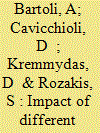| Srl | Item |
| 1 |
ID:
132630


|
|
|
|
|
| Publication |
2014.
|
| Summary/Abstract |
The recent low CO2 prices in the European Union Emission Trading Scheme (EU ETS) have triggered a discussion whether the EU ETS needs to be adjusted. We study the effects of CO2 price floors and a price ceiling on the dynamic investment pathway of two interlinked electricity markets (loosely based on Great Britain, which already has introduced a price floor, and on Central Western Europe). Using an agent-based electricity market simulation with endogenous investment and a CO2 market (including banking), we analyse the cross-border effects of national policies as well as system-wide policy options.
A common, moderate CO2 auction reserve price results in a more continuous decarbonisation pathway. This reduces CO2 price volatility and the occurrence of carbon shortage price periods, as well as the average cost to consumers. A price ceiling can shield consumers from extreme price shocks. These price restrictions do not cause a large risk of an overall emissions overshoot in the long run. A national price floor lowers the cost to consumers in the other zone; the larger the zone with the price floor, the stronger the effect. Price floors that are too high lead to inefficiencies in investment choices and to higher consumer costs.
|
|
|
|
|
|
|
|
|
|
|
|
|
|
|
|
| 2 |
ID:
149972


|
|
|
|
|
| Summary/Abstract |
The growing demand of maize silage for biogas production in Northern Italy has triggered an intense debate concerning land rents, maize prices and their possible negative consequences on important agri-food chains. The aim of this work is to quantify the extent to which the rapid spread of biogas raised the maize price at regional level, increasing the demand of land for energy crops. For this purpose we applied a partial-equilibrium framework simulating the agricultural sector and the biogas industry in Lombardy, under two alternative schemes of subsidization policy. Results show that policy measures implemented in 2013 – reducing the average subsidy per kWh – may contribute to enforce the complementarity of the sector with agri-food chains, decreasing the competition between energy and non-energy uses. Compared to the old scheme, maize demand for biogas would decrease, lessening the market clearing price (as well as feed opportunity cost for livestock sector) and reducing land demand for energy purposes.
|
|
|
|
|
|
|
|
|
|
|
|
|
|
|
|